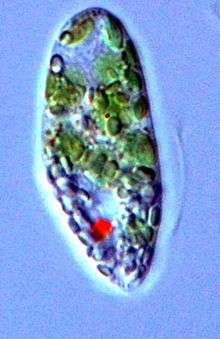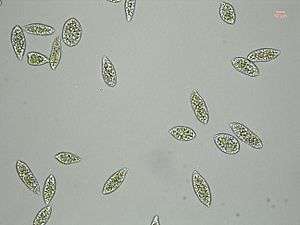Euglena gracilis
Euglena gracilis is a freshwater species of single-celled alga in the genus Euglena. It has secondary chloroplasts, and is a mixotroph able to feed by photosynthesis or phagocytosis. It has a highly flexible cell surface, allowing it to change shape from a thin cell up to 100 µm long, to a sphere of approximately 20 µm. Each cell has two flagella, only one of which emerges from the flagellar pocket (reservoir) in the anterior of the cell, and can move by swimming, or by so-called "euglenoid" movement across surfaces. E. gracilis has been used extensively in the laboratory as a model organism, particularly for studying cell biology and biochemistry.[3]
| Euglena gracilis | |
|---|---|
 | |
| Scientific classification | |
| Domain: | |
| (unranked): | |
| Division: | |
| Class: | |
| Order: | |
| Family: | |
| Genus: | |
| Species: | E. gracilis |
| Binomial name | |
| Euglena gracilis Klebs, 1883 | |
Taxonomy

A morphological and molecular study of the Euglenozoa put E. gracilis in close kinship with the species Khawkinea quartana, with Peranema trichophorum basal to both,[4] although a later molecular analysis showed that E. gracilis was, in fact, more closely related to Astasia longa than to certain other species recognized as Euglena. The transcriptome of E. gracilis was recently sequenced, providing information about all of the genes that the organism is actively using. They found that E. gracilis has a whole host of new, unclassified genes which can make complex carbohydrates and natural products.[5][6]
References
- Adl, SM; Simpson, AG; Lane, CE; Lukeš, J; Bass, D (2012). "The Revised Classification of Eukaryotes". Journal of Eukaryotic Microbiology. 59 (5): 429–493. doi:10.1111/j.1550-7408.2012.00644.x. PMC 3483872. PMID 23020233.
- Guiry, MD; Guiry, GM. "Algaebase Taxonomy Browser". Algaebase. National University of Ireland. Retrieved 2015-05-11.
- Russell, A. G.; Watanabe, Y; Charette, JM; Gray, MW (2005). "Unusual features of fibrillarin cDNA and gene structure in Euglena gracilis: Evolutionary conservation of core proteins and structural predictions for methylation-guide box C/D snoRNPs throughout the domain Eucarya". Nucleic Acids Research. 33 (9): 2781–91. doi:10.1093/nar/gki574. PMC 1126904. PMID 15894796.
- Montegut-Felkner, Ann E.; Triemer, Richard E. (1997). "Phylogenetic Relationships of Selected Euglenoid Genera Based on Morphological and Molecular Data". Journal of Phycology. 33 (3): 512–9. doi:10.1111/j.0022-3646.1997.00512.x.
- The potential in your pond published on August 14, 2015 by the "John Innes Centre"
- O'Neill, Ellis C.; Trick, Martin; Hill, Lionel; Rejzek, Martin; Dusi, Renata G.; Hamilton, Christopher J.; Zimba, Paul V.; Henrissat, Bernard; Field, Robert A. (2015). "The transcriptome of Euglena gracilis reveals unexpected metabolic capabilities for carbohydrate and natural product biochemistry". Molecular BioSystems. 11 (10): 2808–21. doi:10.1039/C5MB00319A. PMID 26289754.